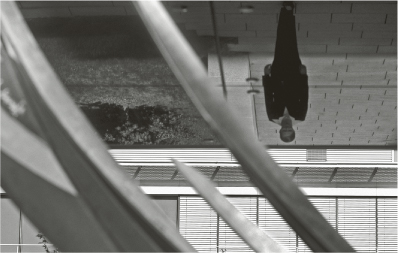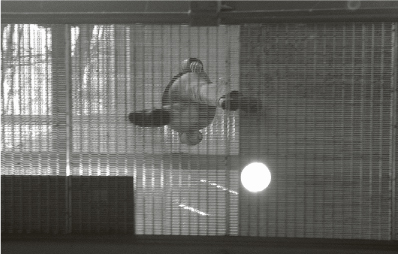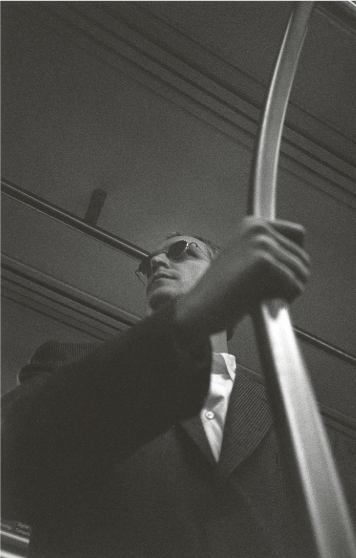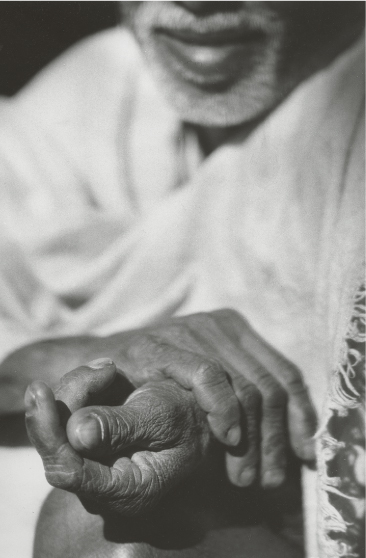23 Unusual Perspectives
Good photography is the result of the photographer developing an individual style and using it to express what he/she really cares about. Perspective, used to photograph the subject within its surroundings, plays an important role in this expression. To best use perspective, it is essential for you to know the principles of the various focal distances. Please allow me to repeat this once again as it cannot be stressed often enough: Reality is three-dimensional, but photography forces this three-dimensional reality onto a two-dimensional surface. And on this surface, different spaces are placed in certain relationships to one another even though they often have no connection to each other in real life. The wide-angle lens is the most suitable tool for joining two radically different premises. The wide-angle lens has other advantages for making use of unusual perspectives:
• It distorts perspective.
• It makes objects stand out from the normal visual horizon.
• Faces look strange.
• Buildings acquire dynamic vanishing points.
• The foreground and background look completely different.
Thus, wide-angle lenses are particularly suitable for playing with unfamiliar perspectives. (Telephoto lenses, on the other hand, compress spaces and can make them look like a jumbled mass.)
The Russian photographer Aleksandr Rodchenko, mentioned earlier, was a pioneer in the use of unfamiliar perspectives. One of his best-known pictures shows a trumpet player photographed from below and with his cheeks full of air. However, with regard to architecture, he turned the world literally upside down—the most unusual views of the world were his trademark. To follow his steps means to analyze the objects that you want to photograph from all possible angles. You need true enthusiasm to even lie down on the ground and get your clothes dirty or to climb a ladder or shoot from a rooftop; these are small prices to pay to capture an unusual photo.
Another master of unusual views was Otto Steinert, who became known for “subjective photography.” This former teacher in Essen’s Folkwang School was one of the most important postwar German photographers. He taught his pupils to use photography to express the various facets of their personalities. To bring such a subjective expression into their own photos, it was necessary to surrender to their own intuition in the search for subjects. Once the place was found in which the “inner pendulum” had swung, they would explore it thoroughly. It was essential to be disciplined and look at the subject from all perspectives first, allowing unconventional views to be discovered before photographing it. These unconventional views, in turn, were one of many requirements for developing an individual pictorial language.
Headstand
You may think that the photo in figure 23–1 has been printed upside down. Not so! The woman appears to be upside down because the photo is of her reflection. The photo was taken in an interesting building complex in Frankurt’s suburb of Taunus, where there are bridges made of glass that link one building to another. And these bridges are reflected from below. In the upper part of the photo, you see the lower part of a reflective bridge in which the woman is mirrored, and she seems to be doing a headstand. A certain distance behind, you can recognize a section from the main building. In the foreground are the top sections of a moving sculpture. Because these sections were constantly changing, it was very important to make sure that they would fit into the composition. They have a vital function in this photo because they break the strict dual division of the image and bring a dynamic quality into it. Even here, it was essential to look carefully at the subject first and to turn the world upside down later.

The photo was taken digitally and was converted to black and white using Photoshop. I brightened the upper part of the frame, having selected it with the Polygonal Lasso, and increased contrast for the entire image.
Person from Below
The photo in figure 23–2 captures a rare look at a person at Berlin’s Potsdam Square. From the basement of the Sony Center, you can look up to this lath floor. It was important to shoot at the instant when the woman had both feet on the ground to achieve this unusual perspective of a walking person. It was also important to make sure the woman would be in the middle: Her centered position structures the pictorial composition and makes her stand out from a calm, medium-gray background. She would not have stood out well had she been in the right part of the photo, and the left part would have been too cluttered. However, it is advantageous for pictorial tension that you can see a couple of graphic shapes in the image (the roof of the Sony Center) that provide some tension with respect to the round light in the lower right. Without this light, the entire right side of the image would have been dead.
This photo was also taken digitally at full aperture and a shutter speed of ![]() s which led to a slight blur because it was shot without a tripod. Photoshop’s Smart Sharpen tool counteracted this blur a little bit.
s which led to a slight blur because it was shot without a tripod. Photoshop’s Smart Sharpen tool counteracted this blur a little bit.

Indian Village
A divergence from the classical viewpoint is also the crucial design element in the photo in figure 23–3: Instead of focusing on the face, why not focus on the hands? To achieve this, it was necessary to get to know life in a primal Indian village intimately and become so familiar with the villagers that as a photographer I could move around freely and people would regard it as normal as I took their photos.
This photo is of a man who leads a very simple life, compared to our standards, and has devoted his entire life to farming and cattle breeding. His worn hands tell his story. The man’s face is somewhat blurred in the background, though his gray beard suggests that he is old. The pictorial tension of this photo is found in the way the two poles (i. e., the two hands) and the blurred part of the face relate to each other.
The photo was taken with an analog camera and a 50 mm lens.
compositional poles: Used in a picture with more than one center of attention, they are usually placed toward the edges to achieve a so-called bipolar pictorial composition. If the two poles are equivalent, the eye does not rest because it will always keep moving back and forth between the two.
New York Subway
The photo in figure 23–4 tells the story of a different world: A young man wearing sunglasses and a jacket holds on to the handle of a New York subway car. Here, we have once again an unusual perspective from below that makes the image interesting. The man’s arm running diagonally through the image greatly dominates the composition and makes it highly dynamic. The braces in the roof of the subway car run obliquely in an opposite direction, and one brace even runs across the man’s face, almost giving the impression that he has been skewered.
In contrast to the photo of the Indian, this man radiates coldness; the subway is only a fleeting place of residence in the fast-paced microcosm of urban life. Whereas the photo of the Indian conveys deep roots and tranquility, this image shows us the dynamic hustle and bustle of New York urban life in which the individual remains anonymous, even hiding behind sunglasses in the rather dark world of the subway car.
Edward Weston started photographing people in the New York subway as early as in the 1920s. He hid his camera behind his jacket and shot the photo through a button hole. To take this photo, I placed the camera on my knee, and the composition was a calculated guess because I could not see through the viewfinder. With a little practice, it is possible to shoot people without them noticing (in this case, the clicking of the Mamiya wasn’t heard because of the loud sound of the moving subway) and thus obtain acceptable pictorial compositions with unusual perspectives, as is the case here.
This photo was taken with an analog Mamiya 645 and a Fuji Neopan 400 pushed to 800 ASA using a super-wide-angle lens.


